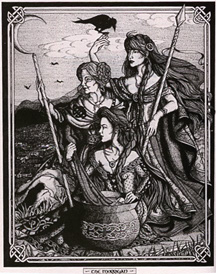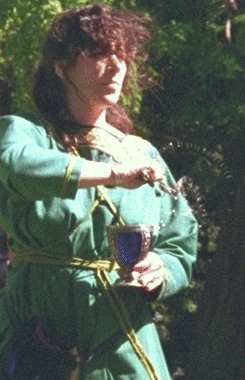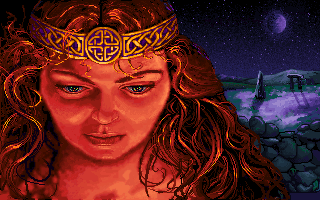 |
 |
 |
 |
 |
 |
 |
 |
 |
 |
 |
 |
 |
 |
 |
 |
 |
 |
 |
 |
 |
 |
 |
 |
 |
 |
 |
 |
 |
 |
|
|
|
|
|
|
 |
|
|
|
THE BASICS AND THEORIES OF
WICCA |
|
|
|
 |
|
|
|
Although much of Wicca is derived from the practices of ancient civilisations, Wicca as it is today is NOT the same. Most of the myths surrounding Wicca are not surrounding Wicca itself, but the word "Witchcraft" when Wiccans are attempting to explain their beliefs to others. The few fragments of the ancient cultures that were left in today's society were pieced together, had the gaps filled in and then formed a religion no more than 60 years ago. So, although Wicca comes from the ancients, it is not the same religion as they once practiced. |
|
|
|
 |
|
|
|
The most identifying symbol of Wicca is the pentagram. So, what exactly does it symbolise? The following is my interpretation (you and others may agree with parts of it, or you may not):
THE STAR is the symbol of protection. Each of its five points represents a different element, the whole symbol being a unified elemental force (EARTH - bottom left point; AIR - top right point; FIRE - top left point; WATER - bottom right point; AKASHA (SPIRIT) - top point).
THE CIRCLE surrounding the star I interpret as representing the Circle of Power, a tool of Wicca. Also, it links all points to each other in a more direct fashion. |
|
|
|
|
|
As you can see, there can be no ram's head within the pentagram, there is no face of Satan, and the symbol cannot be used to invoke such an evil deity. Wiccans have not, do not and will not worship the Christian deity of evil. |
|
|
 |
|
|
Wiccans worship two deities - the god and goddess (sometimes referred to as the Lord and Lady). Both deities together symbolise all within nature, and originate from Akasha. When particular aspects of the god or goddess is required, then they are referred to as the specific name (e.g. the Goddess of the Earth and the Home may be referred to as Gaia).
The Goddess is heavily accented in Wicca. She is the Maiden of Spring, the Mother Earth, and the Crone of death and rebirth (all three aspects pictured right). Each aspect has Her own time within the Wheel of the Year - Her own festival celebrating the aspect she represents.
In Wicca, there is no Heaven in which to rejoice in, and no Hell in which to be damned to. It merely IS. |
|
|
|
|
|
|
In the process of learning Wicca (this learning process is a life-long thing - nobody knows everything), an initiate within a coven may spend up to four years, each year having a different level of achievement. This is no cop-out religion for those who are not true of heart to say they belong to. During this learning process, an initiate decides which Tradition of Wicca to practice. Among the most popular traditions are Celtic and Greek. However, there is a Tradition for every ancient culture, it is merely your own personal choice to decide which speaks to you most or works for you best. This can only be done by trial and error, listening and learning. No matter what you decide to look into to begin your quest, you will learn from it, so there is no wastage of time for you to look back upon. Once your Tradition has been decided, then the fun begins... |
|
|
 |
|
|
The practice of magick is the thing that determines whether or not you are a witch. I do not know any Wiccans who do not practice magick, and because of that are not witches, but I do know witches who do not follow the beliefs of Wicca and because of that are not Wiccans. So, there is the riddle. All Wiccans are witches but not all witches are Wiccan.
The woman on the left is consecrating the ground of the Circle. The text of the Wiccan Rede, the basic code of practice which all Wiccan follow, says "Cast the Circle thrice about to keep the evil spirits out". Basically, a Circle is required every time you wish to practice magick with the aid of a deity or elemental being, and should be cast. It is not required for communion with the deities.
Rituals are performed every Sabbat (each Festival in the Wiccan Year). They work best when composed by yourself and for yourself (in the case of a solitary - covens will have their own way of celebrating Sabbats). Although a ritual can be held at any time of the month, the most popular is on the night of the Full Moon. |
|
|
|
|
On every Sabbat, and almost all Esbats (full moon), the Charge of the Goddess is recited, either by yourself (solitary) or the High Priestess (coven). This is also referred to as Drawing Down the Moon. When an Esbat is held on the night of a new moon or when the moon is waning, then the Charge of the Dark Goddess is recited. Whenever a Charge is recited for whatever aspect of the Goddess, the Charge of the God is (usually) also recited.
I've already mentioned some of the differences between Wiccan Solitary practices and Wiccan coven practices. A coven is a structured group of Wiccans that meet every esbat and Sabbat in order to practice magick and enjoy the company of one another. They have a High Priest and a High Priestess that lead these meetings, although they view each other as being equal and value everybody's opinions. A solitary is a Wiccan that chooses to go it alone. They learn by reading, experimenting and practicing at their own pace. The solitary appears to have more freedom with their Tradition than a coven member does, but the life of a solitary can be a long and lonely path. For this reason, many solitaries are part of study groups, learning magick together with others without the coven structure. |
|
|
|
 |
|
|
|
FURTHER READING
I'd recommend any of Scott Cunningham's books - especially "Wicca - A Guide for the Solitary Practitioner". For those interested in a more Australian perspective on Wicca, then I recommend Fiona Horne's book "Witch - A Personal Journey". The Modern Witchcraft series is also very good (there's three books), but it too gives a Northern Hemisphere aproach. |
|
|
|
 |
|
|
|
See my LINKS page for more Wiccan websites...
ENTRANCE | HOME | DRUIDIC LORE |
|




